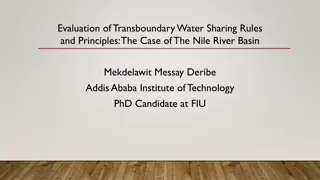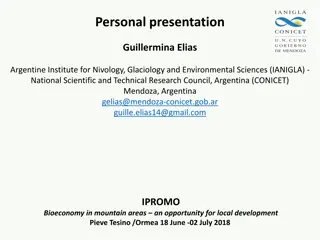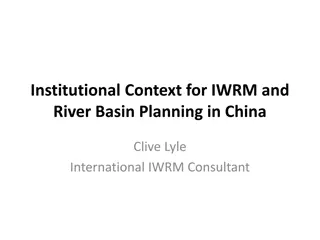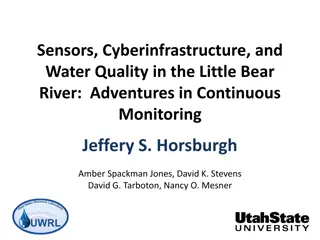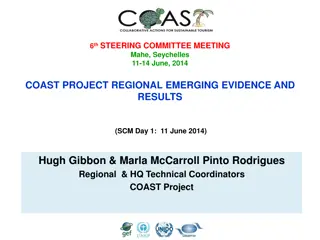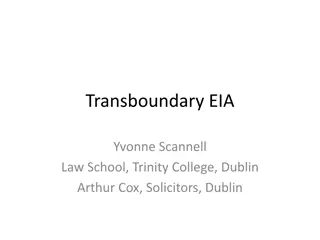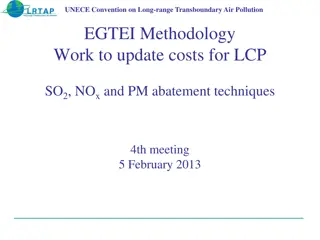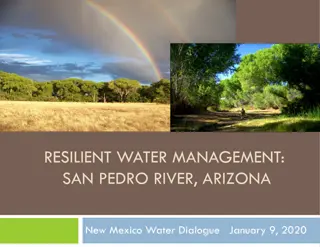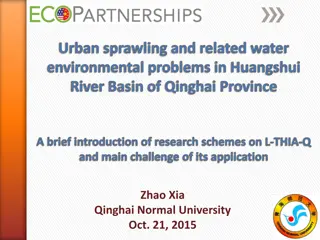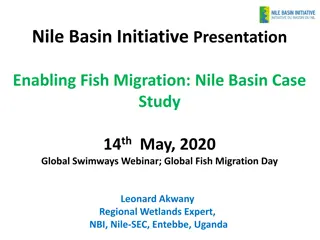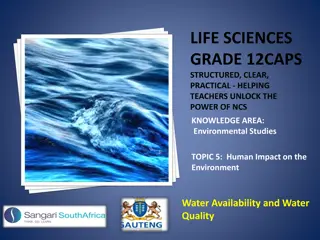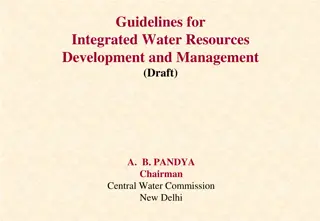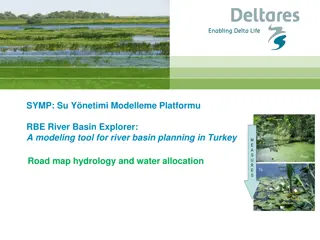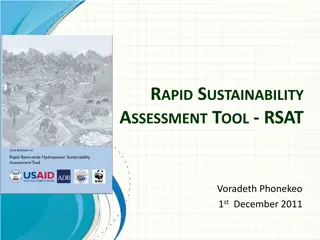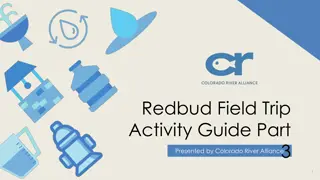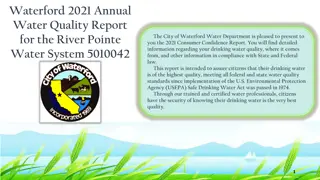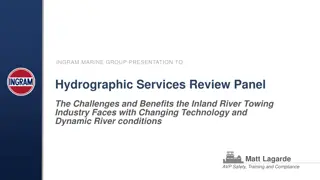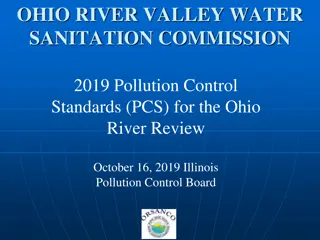Challenges of Transboundary Water Management: A Focus on Kosi River
This paper by Dr. Shilpa Bagade delves into the issues and challenges associated with transboundary water management, with a special emphasis on the Kosi River. It discusses the hydrology, climate change impacts, and the Kosi agreement between India and Nepal. The geographical origins and drainage basin of the Kosi River are also explored, highlighting the complexities of managing shared water resources in the region.
Download Presentation

Please find below an Image/Link to download the presentation.
The content on the website is provided AS IS for your information and personal use only. It may not be sold, licensed, or shared on other websites without obtaining consent from the author. Download presentation by click this link. If you encounter any issues during the download, it is possible that the publisher has removed the file from their server.
E N D
Presentation Transcript
Issues and Challenges of Transboundary Water Management with Special Reference to Kosi River Dr. Shilpa Bagade Ph.D(Law) LL.M, M.A.(Pol. Sci.), M.A.(Socio) and PG Diploma in Human Rights
To understand the structure and nature of the basin, this paper describes the hydrology, meteorology, geology, geomorphology of the river and characteristics of water hazards in the basin well as. The issues relating due to erratic nature Kosi River will be explored in this paper. The Kosi River being one of the Himalayan Rivers, the issues relating to climate change as well as sustainable development will be discussed. The paper will review the Kosi agreement between India and Nepal and explore the weakness of the agreement. The water relationship between India and Nepal will be highlighted in the perspective of International Law.
Transboundary Water Resources Approximately 40 per cent of the world s population lives in river and lake basins that comprise two or more countries, and perhaps even more significantly, over 90 per cent lives in countries that share basins. The existing 276 transboundary lake and river basins cover nearly one half of the Earth s land surface and account for an estimated 60 per cent of global freshwater flow. A total of 148 States include territory within such basins, and 21 countries lie entirely within them. In addition, about 2 billion people worldwide depend on groundwater, which includes approximately 300 transboundary aquifer systems. Sources: Transboundary Waters: UN-Water Thematic Paper Sharing Benefits, Sharing Responsibilities, 2008; UNESCO, 2013
Geography of Kosi River The river Kosi originates at an altitude of over 7000 m above MSL in the Himalayas. Kosi river drains the northern slopes of the Himalaya in the Tibet Autonomous Region and the southern slopes in Nepal. From a major confluence of tributaries north of the Chatra Gorge onwards, the Kosi River is also known as Saptakoshi for its upper seven tributaries. These include the Tamur Koshi originating from the Kanchenjunga are in the east, Arun River and Sun Koshi from Tibet. The Sun Koshi s tributaries from east to west are Dudh Koshi, Bhote Koshi, Tamba Koshi and Indravati Koshi. The Saptakoshi crosses into northern Bihar where it branches into distributaries before joining the Ganges near Kursela in Katihar district. The upper catchment of the river system lies in Nepal and Tibet.
Heartbreakin g scenes Houses washed away Walked miles in water to find shelter Railway track washed away
Regulations Relating to Transboundary Water Sharing The UN Convention on the Law of the Non-navigational Uses of International Watercourses 1997 The resolution was based on four doctrines 1. The Harmone Doctrine 2. Doctrine of Absolute Territorial Integrity 3. Doctrine of Limited Territorial Sovereignty & Integrity 4. Doctrine of One Riparian Community
Treaty Provision Basically, this project is to build a barrage on the Kosi river to confine the river which shifts course frequently, and prevent floods in Bihar and divert water for irrigation. The 1.15 km barrage, completed in 1962, is wholly in Nepal, and the Eastern Main Canal is entirely in India. Nepal is allowed to withdraw water from Kosi and its tributaries for irrigation and other purpose; India has the right to regulate the balance at the barrage site from time to time for irrigation and to generate hydro power from eastern main canal. Over a period of time the Kosi Agreement was revised in 1966. This revision of the treaty has made no provision for irrigation in Nepal from the project. However agreements and understandings through an exchange of letters made the following provisions. An additional Agreement between India and Nepal as of 7 April 1978 made provision for the renovation and extension of irrigation facilities developed earlier in Nepal. India met the cost of such renovation and extension.
The Western Main Canal first passes through a 35 km stretch of Nepal territory. The Western main Canal, completed only in 1982, was designed to irrigate 356,000 hectares as far west as Darbhanga. Nepal was to receive water from the Western Canal to irrigate 11,000 hectares. The other major component of the project was the 220 km of embankment jacketing the Kosi on both banks. Such irrigation facilities included the Chandra Canal receiving water from the tributary of the Koshi River, Pump Canal constructed earlier to lift water from the western main canal to irrigate lands in Nepal, and command area development of the Western Kosi Canal Project.
Weakness of the Kosi Treaty The weaknesses of the treaties are as follows: Deviating from the Purpose The Kosi Treaty, originally designed to help control flooding of the Kosi River contains no specific clause for flood control mechanisms or compliance in cases where the flood control structures either fail or are damaged. However Irrigation became prime focus for both of the states and Irrigation departments lead the Kosi projects. There are no institutions institutionalized especially for disaster preparedness under the Kosi Treaty and the Kosi project.
No provision for flood affected People There were no compensation schemes for the people who would be affected by the flood if the embankment was breached. In short, the possibility of the occurrence of a future flood was not addressed. Respondents opined the over confidence over the output of the embankments is one of the many reasons. Moreover, there are still no policies and strategies legislated in Nepal for disaster risk reduction which the Nepal government claimed that it is working on it. The Kosi treaty was signed by Nepal and India and decisions are made at a national level. Local governments, local people and civil society were not included in the process of decision making or in the management of the Kosi project; nor are they included in the new institutional design. Neither the local people, nor the local government and community based organizations are aware of the detail of the Kosi Treaty.
Failure of Institutional Mechanism There is no clear provision in the Treaty when, who and how monitoring would be conducted. The institutional mechanism of the Kosi project does not apportion any responsibility for the maintenance and monitoring on the Nepalese side of the river even though some parts of the embankments are in Nepalese territory. Therefore, when the embankments breached in Nepal, it proved difficult for India to provide timely action to repair the damage in Nepalese territory as there were no provisions for such measures in the Kosi treaty. There are many bilateral committees in the middle of the hierarchy for the management of the same river. This has caused an overlap of responsibility for many tasks. The output of these committees has not been satisfactory. A streamlined division of responsibility and authority to actors at different levels of governance, and emergency procedures are not mentioned.
Communication Mechanism The current communication mechanism is indirect, lengthy and unaccountable. In treaty there is no provision for direct communication from the Kosi project, WRD, GOB with local and central government of Nepal. Jurisdiction not Mentioned The issues of jurisdiction of land and sovereignty were not addressed. Nepal had the responsibility of keeping law and order in the project area under her territorial jurisdiction. No provision for Disaster Management There is no clear provision in the treaty for dealing with a flood when it does occur. There were no contingency plans in place should the embankment breach. There is merely a maintenance plan for the embankments, the responsibility of which fell to India.
Maintenance The treaty has not explained the responsibility for every aspect of maintenance. It would help if the treaty is clear about when and how this work is to be carried out. As Nepal is the first victim of any disaster upstream of the barrage, it would be easier for the management of the Kosi project if Nepal would be given responsibility for maintenance of embankments that are in Nepalese territory.
Conclusion: It is urgently needed to institutionalise participatory governance in the Kosi basin, so that people in whose name all this is being pushed have a role. What is claimed to be solutions today are certain to be problem tomorrow, as is clear from the experience of Kosi embankment. Kosi and its people will not allow more of such faulty prescriptions. Kosi belongs to the ecosystem and all of society. The river must be allowed to perform its role in maintaining a natural evolutionary balance and continuing with its land building work. Both states local public participation is required.
T H A N K S



